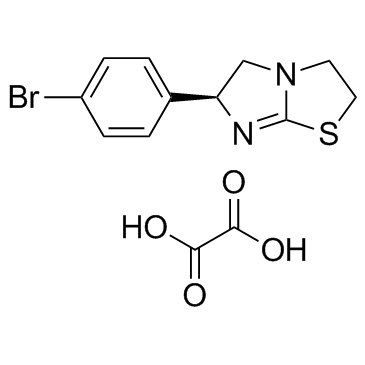(-)-p-Bromotetramisole oxalate

(-)-p-Bromotetramisole oxalate structure
|
Common Name | (-)-p-Bromotetramisole oxalate | ||
|---|---|---|---|---|
| CAS Number | 62284-79-1 | Molecular Weight | 373.22200 | |
| Density | N/A | Boiling Point | 388.6ºC at 760 mmHg | |
| Molecular Formula | C13H13BrN2O4S | Melting Point | 192ºC (dec.) | |
| MSDS | Chinese USA | Flash Point | 188.8ºC | |
| Symbol |

GHS07 |
Signal Word | Warning | |
|
Chemical genetics reveals a complex functional ground state of neural stem cells.
Nat. Chem. Biol. 3(5) , 268-273, (2007) The identification of self-renewing and multipotent neural stem cells (NSCs) in the mammalian brain holds promise for the treatment of neurological diseases and has yielded new insight into brain cancer. However, the complete repertoire of signaling pathways ... |
|
|
Genetic mapping of targets mediating differential chemical phenotypes in Plasmodium falciparum.
Nat. Chem. Biol. 5 , 765-71, (2009) Studies of gene function and molecular mechanisms in Plasmodium falciparum are hampered by difficulties in characterizing and measuring phenotypic differences between individual parasites. We screened seven parasite lines for differences in responses to 1,279... |
|
|
Endothelial progenitor cells proliferated via MEK-dependent p42 MAPK signaling pathway.
Mol. Cell Biochem. 400(1-2) , 201-6, (2015) Endothelial progenitor cells (EPCs) clinical applications have been well reported. However, due to low number of EPCs that could be isolated, EPCs expansion study became one of the main focuses. Some optimized mediums to culture EPCs were currently available.... |
|
|
Inhibition of human alkaline phosphatase isoenzymes by the affinity reagent reactive yellow 13.
Enzyme 33(2) , 70-4, (1985) The dye Reactive Yellow 13, an affinity reagent for intestinal alkaline phosphatase, inhibits intestinal and other human alkaline phosphatases in solution. The inhibition depends markedly on the presence of a phosphate acceptor such as diethanolamine. The dye... |
|
|
Further characterization of serum alkaline phosphatase from male and female beagle dogs.
Enzyme 42(1) , 1-7, (1989) Alkaline phosphatase (AP) from the sera of both male and female beagle dogs was partially purified and then analyzed for the presence of AP isoenzymes having intestinal or osseous characteristics as detected by bromotetramisole inhibition or wheat germ lectin... |
|
|
Measurement of alkaline phosphatase of intestinal origin in plasma by p-bromotetramisole inhibition.
J. Clin. Pathol. 44(3) , 236-7, (1991) L-p-bromotetramisole was used to inhibit non-intestinal alkaline phosphatase (of liver or bone origin) (EC 3.1.3.1; ALP) in plasma, and intestinal ALP was measured from the uninhibited activity. The method of determination is convenient and correlated well wi... |
|
|
Effect of bromotetramisole on renal phosphate excretion.
Proc. Soc. Exp. Biol. Med. 213(2) , 193-5, (1996) Levamisole inhibits alkaline phosphatase (ALP) activity in kidney brush border membranes and increases phosphate excretion in vivo in dogs and rats. I-p-Bromotetramisole (I-BR) is a more potent analog of levamisole in regard to inhibition of ALP activity in v... |
|
|
Glibenclamide induces apoptosis through inhibition of cystic fibrosis transmembrane conductance regulator (CFTR) Cl(-) channels and intracellular Ca(2+) release in HepG2 human hepatoblastoma cells.
Biochem. Biophys. Res. Commun. 261 , 682, (1999) Glibenclamide, an inhibitor of cystic fibrosis transmembrane conductance regulator (CFTR) Cl(-) channels, induced apoptosis in a dose- and time-dependent manner in HepG2 human hepatoblastoma cells. Glibenclamide increased intracellular Ca(2+) concentration, w... |
|
|
Inhibitors of tyrosine phosphatases block angiotensin II inhibition of Na(+) pump.
Eur. J. Pharmacol. 406(1) , 49-52, (2000) To determine how angiotensin II inhibits the Na(+) pump (Na(+), K(+)-ATPase) in rat zona glomerulosa, we selectively blocked signaling proteins that could be activated by the angiotensin AT(1) receptor and known to affect Na(+) pump activity. Inhibitors of pr... |
|
|
Effect of alkaline-phosphatase inhibition by 1-p-bromotetramisole on the formation of trichloroacetic acid-[32P]-insoluble phosphate from inorganic [32P]-phosphate and [32P]-pyrophosphate in non-mineralizing and mineralizing hamster molar tooth-germs in vitro.
Arch. Oral Biol. 32(6) , 429-32, (1987) In culture, 1-p-bromotetramisole (pBTM), a specific inhibitor of alkaline phosphatase, significantly inhibited the formation of trichloroacetic acid (TCA)-insoluble [32P]-phosphate from inorganic [32P]-phosphate in the proliferating non-mineralizing second (M... |